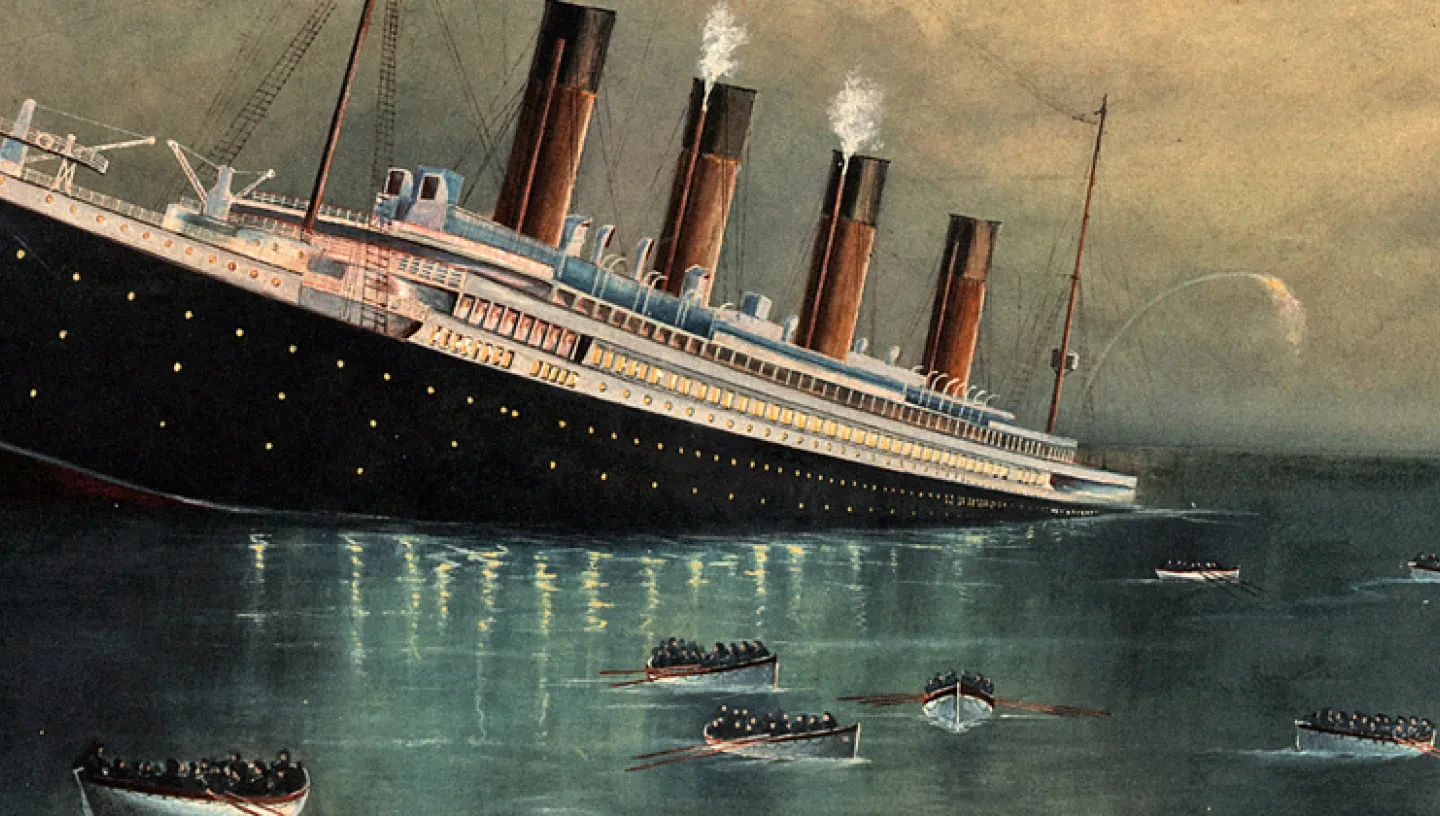
The Titanic in popular culture
A hundred years ago, the world was awash in songs, poems, films and paintings about the Titanic.
The sheer scale of the tragedy alone makes RMS Titanic’s story a significant one. But there are other elements of the infamous story that caught the popular imagination and have kept it gripped ever since.
Films
Whilst RMS Titanic is inexplicably linked with the 1997 film in many of our minds, there have in fact been numerous films featuring the famous ship.
- Within a month of its subject's demise, Saved from the Titanic was released in the USA. The short silent film told the story of actress Dorothy Gibson, who starred in the film, and her escape from the disaster.
- Atlantic, a British 'talking movie' came out in 1929. It told the story of the Titanic but didn't use the name of the ship for legal reasons
- In 1943 Nazi Propaganda Minister Joseph Goebbels produced a film in which tragedy comes after a heroic German officer is ignored. The film was designed to showcase German filmmaking but also to suggest that British and American capitalism were to blame for the Titanic disaster.
- 1997 blockbuster Titanic was the most expensive film ever made at the time and was nominated for 11 Oscars at the 70th Academy Awards.
On canvas
Both the ship itself, and its sinking have been popular themes for artists and live within a long history of maritime tragedies being immortalised in paint. The National Maritime Museum has a number of outstanding paintings of the Titanic, including a pencil drawing of the ship sinking, drawn by a steward aboard the ship. This is the only depiction of the ship sinking by a survivor of the disaster.

Find out more about our collection
Popular music
The story of RMS Titanic immediately struck a chord with the public on both sides of the Atlantic. Within two years of the tragedy, over a hundred songs had been written about the ship. The first song about the ship was copyrighted a mere fortnight after the tragedy.
Songs saluted the brave, expressed sympathy for those who lost their lives but often featured some or all of the following themes.
An affront to God
For many people, naming a ship after a race of Heathen gods was bad enough (The name Titanic is derived from the name of the Greek God Titan).
Claiming that it was unsinkable as well was seen by many as simply asking for divine retribution.
This would be a theme taken up by balladeers and bluesmen repeatedly.
Named it a name of God in a tin, without a "c", Lord, he pulled it in
God moves, ah, God moves, God moves, ah, and the people had to run and pray
Blind Willie Johnson
Class
Just as it forms a central part of the 1997 film, the issue of class was a frequent theme in music. The indifference of the rich to the fate of the poor was a common trope, as well as the occasional example of the reverse. The most popular song to come out of the immediate aftermath of the tragedy has these lines:
When that ship left England it was making for the shore,
The rich had declared that they would not ride with the poor,
So they put the poor below,
They were the first to go.
'The Great Titanic' (1915)
On the other hand, millionaire captain of industry John Jacob Astor was celebrated for his sacrifice:
There was John Jacob Astor,
What a brave man was he
When he tried to save all female sex,
The young and all, great and small,
Then got drowned in the sea
'The Titanic is Doomed and Sinking'
Race
It was widely believed that RMS Titanic was a 'whites only' ship. None of the crew and quite possibly none of the passengers were black (although an account of a Haitian man boarding at Cherbourg came to light much later).
Popular legend also had it that black heavyweight boxing champion Jack Johnson was refused a passage with the captain allegedly responding, “we ain't hauling coal.” The tale was popularised by bluesman Leadbelly in his 'Titanic' song which ends with the lines:
Black man oughta shout for joy,
Never lost a girl or either a boy.
Cryin', 'Fare thee Titanic, fare thee well!
'Titanic' Huddie Ledbetter
With poor race relations in the United States at the time, tales of racist white people being undone by their own vanity were popular in music.
Courage and villainy
In many popular songs Captain Smith is portrayed as the villain, as he races across the ocean.
However, in other accounts it is J. Bruce Ismay, president of the company who built Titanic who is portrayed as a villain. This is particularly true of accounts from powerful American news proprietor William Randolph Hearst, who was angry that Ismay hadn’t co-operated with the press years before.
Whilst Ismay was exonerated in a British inquiry, which noted how he'd helped others before boarding the last boat, Hearst's account triumphed in the popular imagination.
The worst loss of life ever
The unprecedented nature of the tragedy ensured it was global news.
Within two years though, the world would be at war and the tragedy would fade from people’s consciousness.
Despite this, it has retained its status as if not the worst loss of life at sea, at least the worst loss in peacetime. However, it is neither.
The greatest maritime disaster in peacetime happened in December 1987, when the Philippine inter-island ferry Doa Paz collided with the Vector, a small coastal petrol tanker. 4386 people lost their lives, over 1000 of them were children.
Entry to the National Maritime Museum is free, open daily from 10am
